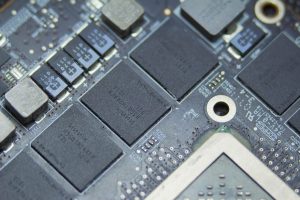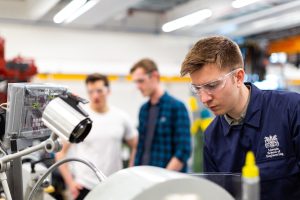What Does Flip Mean in Robotics Engineering When you think of robotics engineering, you might immediately picture machines that perform complex tasks with precision, or robots mimicking human movements. But there’s a specific term in robotics that you might come across—flip. It’s a term that’s more than just a basic movement; it has intricate applications in the way robots interact with their environment. Understanding what flip means in robotics engineering can offer valuable insights into robot design, motion planning, and functionality. In this article, I’ll dive deep into the concept of flipping in robotics, explaining its significance, application, and how it plays a role in advancing robotics technology.
If you’re wondering what exactly “flip” means in the context of robotics engineering, you’re in the right place. Let’s explore this term in detail and understand its importance in modern robotic systems.
Understanding the Concept of “Flip” in Robotics Engineering
In the world of robotics engineering, “flip” refers to the motion or behavior in which a robot or robotic component rotates or turns over, usually around a fixed point or axis. This could involve a simple flipping motion where a robot performs a full 180-degree turn or more advanced forms like rotational flips. The term “flip” can be applied in various scenarios, from robotic arms flipping objects to mobile robots flipping themselves during recovery from a fall.
At its core, flipping is often a means for a robot to navigate, interact with objects, or perform actions that require agility and dexterity. Robotics engineers use this concept in different applications, including manufacturing, service robotics, autonomous vehicles, and even in human-robot interaction scenarios.
You also may like to read this: What Does Digital Penetration Mean? Exploring Its Impact on Technology and Business
Why Is Flipping Important in Robotics?
The ability to flip can be a crucial feature in certain robotic applications, especially when it comes to enhancing mobility, stability, and flexibility. In some cases, robots must flip objects for manipulation tasks, such as rotating items in a manufacturing line or flipping a switch. In other instances, robots need to be able to recover from flips or falls in dynamic environments, making the flip an essential skill for autonomous systems.
Flipping can also refer to mechanisms that allow robots to change orientations for task optimization. For example, a robot designed for picking and placing items might use a flip to rotate objects from one side to another, improving efficiency and accuracy in tasks like sorting or packaging.
Applications of “Flip” in Robotics
To better understand the significance of flip in robotics, it’s helpful to look at some real-world applications. Here are a few ways in which flipping plays a role in robotics:
1. Mobile Robots and Self-Recovery
One of the key areas where flipping is critical is in mobile robots designed to recover from falls or reorient themselves after a displacement. In some designs, robots are equipped with sensors and actuators that detect when a robot has tipped over. These systems enable the robot to execute a “flip” motion to right itself. This kind of self-recovery is essential for ensuring continued operation in real-world environments, where robots are often exposed to unpredictable obstacles and conditions.
2. Robotic Arms for Object Manipulation
In industrial and service robotics, flipping plays a vital role in object manipulation. For example, robotic arms may use a flipping motion to rotate or adjust objects to different orientations. This is particularly useful in tasks like flipping parts on a production line or adjusting an item to fit within a specific configuration. The precision of the flip motion allows robots to handle delicate tasks that require careful adjustments.
3. Robotic Hands and Dexterity
Flipping is also a key feature in robotic hands designed for dexterity. These hands are often designed to manipulate objects of various shapes and sizes. The ability to flip objects with precision is critical in applications like surgery, where robotic hands must flip instruments or adjust the orientation of materials without damaging them.
4. Exploration and Entertainment Robots
In more experimental applications, such as exploration or entertainment robots, flipping can be used to showcase the agility and flexibility of robots. Robots used in performance or as part of demonstrations often use flips and other dynamic movements to impress audiences or navigate challenging terrains. This could involve robots that can flip over obstacles or move in unique ways that showcase their mechanical flexibility.
Tech Specs and Mechanisms Behind Robotic Flips
When engineering robots that can perform flips, several technological considerations come into play. The design must account for both the physical structure of the robot and the control systems that enable these flips.
Here’s an overview of the technical specifications and mechanisms typically involved in robotic flips:
- Actuators and Motors: For flipping to occur smoothly, robots need powerful actuators and motors capable of generating sufficient torque. These actuators must be finely tuned to ensure precise movements, preventing the robot from tumbling too far in one direction.
- Sensors and Feedback Loops: To detect when a flip is needed or to control the robot’s movement, sensors such as gyroscopes, accelerometers, and force sensors are essential. These sensors feed data back into the control system, allowing the robot to adjust its movements in real-time and achieve optimal balance.
- Stabilization Systems: Many robots incorporate stabilization systems that help maintain balance and prevent falling. In some cases, gyroscopic stabilization is used, while in others, sophisticated algorithms govern how robots maintain balance during and after a flip.
- Materials and Weight Distribution: The physical design of the robot, including its materials and weight distribution, affects its ability to perform a flip. Lightweight robots with low centers of gravity are typically more agile, but heavier robots might require more robust mechanisms to perform flips.
Pros and Cons of Flipping in Robotics
While flipping is an innovative concept in robotics engineering, it comes with both benefits and challenges. Let’s take a closer look at the pros and cons of incorporating flipping functionality into robotic systems.
Pros:
- Improved Mobility: Robots capable of flipping can recover from falls or avoid obstacles, increasing their efficiency in dynamic environments.
- Enhanced Dexterity: Flipping allows robots to manipulate objects in more complex ways, improving their flexibility in tasks like sorting, packaging, or assembly.
- Autonomous Recovery: The ability to flip means that robots can autonomously recover from disorientation or mistakes, reducing downtime and the need for human intervention.
Cons:
- Increased Complexity: The design and control systems required for flipping can make robots more complex to engineer and maintain.
- Energy Consumption: Flipping requires significant energy, particularly for heavier robots, which can impact the overall efficiency of the system.
- Risk of Overcomplicating Tasks: In some applications, adding flipping capability may unnecessarily complicate the robot’s task, especially if simpler methods can achieve the same result.
Recommendation for Robotics Engineers
If you are a robotics engineer considering the implementation of flipping motions in your designs, here are a few recommendations:
- Assess Task Requirements: Consider whether flipping is truly necessary for your application. In some cases, simpler movements like rotating or sliding may be sufficient.
- Optimize Energy Efficiency: Since flipping can be energy-intensive, make sure to design energy-efficient systems that minimize power usage while still achieving the desired flip motions.
- Focus on Precision: The effectiveness of flips often depends on the robot’s ability to execute the motion with high precision. Invest in high-quality actuators and sensors to ensure accuracy.
Comparison Table: Flipping Robots vs. Non-Flipping Robots
| Feature | Flipping Robots | Non-Flipping Robots |
| Mobility | High agility and recovery | Limited to fixed movements |
| Complexity | Requires advanced sensors and actuators | Simpler design and control |
| Energy Consumption | Higher due to flips | More energy-efficient |
| Flexibility in Tasks | Can handle complex tasks like object manipulation | Typically suited for specific tasks |
| Cost | Higher initial cost | Lower initial cost |


















